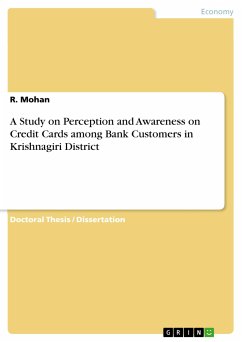
A Study on Perception and Awareness on Credit Cards among Bank Customers in Krishnagiri District (eBook, PDF)

PAYBACK Punkte
0 °P sammeln!
Doctoral Thesis / Dissertation from the year 2017 in the subject Economics - Finance, , language: English, abstract: The study focuses on the perception of card holders towards credit cards. The study was designed to gain a better understanding of the factors influencing 24 possession of credit cards and card holders' satisfaction. The study also analyses the extent of utilization of credit cards by card holders and the level of awareness of bank customers not having credit cards about such cards. A credit card is a small plastic card issued to users as a system of payment. It allows its holde...
Doctoral Thesis / Dissertation from the year 2017 in the subject Economics - Finance, , language: English, abstract: The study focuses on the perception of card holders towards credit cards. The study was designed to gain a better understanding of the factors influencing 24 possession of credit cards and card holders' satisfaction. The study also analyses the extent of utilization of credit cards by card holders and the level of awareness of bank customers not having credit cards about such cards. A credit card is a small plastic card issued to users as a system of payment. It allows its holder to buy goods and services based on the holder's promise to pay for these goods and services. The issuer of the card creates a revolving account and grants a line of credit to the consumer (or the user) from which the user can borrow money for payment to a merchant or as a cash advance to the user. In 1858, the then Finance Minister of the Governor General's Council realized the need of a national bank. With this, the Government was found evincing interest in the development of the organized banking system in the Indian economy. Accordingly, the State Bank of India was set up for extending credit facilities to hitherto neglected areas of the country. However, the needs and requirements, hopes and aspirations of the masses remained neglected till the dawn of independence in 1947. With the attainment of independence, the contours of development underwent radical changes. The Constitution of India assigned an overriding priority to social welfare and equating regional imbalance. The policy makers realized that the establishment of small affluent islands around the vast sea of backwardness was not the real purpose of promoting the financial institutions. The beginning of the planned concept of development way back in 1951 opened new vistas for the development of banking sector. The policy makers felt that the banking sector was not contributing substantially to the development and welfare of Indian society due mainly to the fact that they were working under the private sector with the sole motto of making profits. This engineered a strong foundation for the nationalization of commercial banks.
Dieser Download kann aus rechtlichen Gründen nur mit Rechnungsadresse in A, B, BG, CY, CZ, D, DK, EW, E, FIN, F, GR, HR, H, IRL, I, LT, L, LR, M, NL, PL, P, R, S, SLO, SK ausgeliefert werden.













